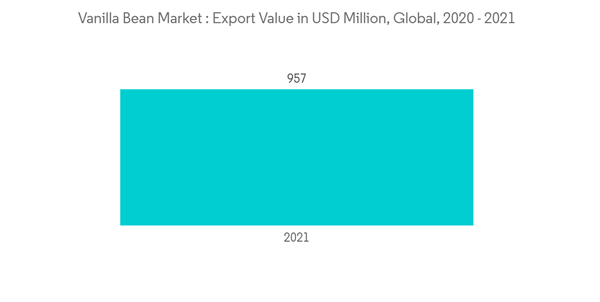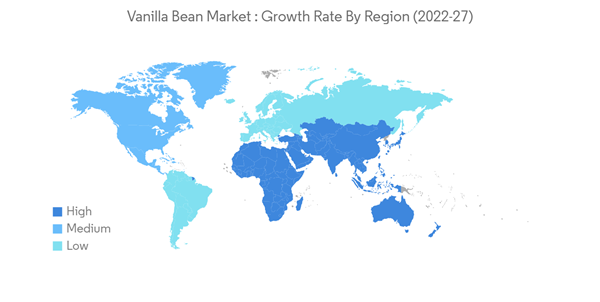The Vanilla Bean Market size is estimated at USD 2.16 billion in 2024, and is expected to reach USD 2.46 billion by 2029, growing at a CAGR of 2.60% during the forecast period (2024-2029).
Vanilla is majorly produced in countries like Madagascar, Indonesia, Mexico, and China. The United States, France, and Germany are the major importer of vanilla. Madagascar accounts for over half of the world's vanilla output and contributed more than half of the world's export value in 2021. Although Madagascar retains the gold standard for vanilla quality, Indonesia is rising to the potential to become a viable alternative origin in terms of both quantity and quality. Due to increased vanilla demand by the super-premium ice cream business, vanilla exports from Madagascar, Indonesia, and other producing nations are expanding, mainly to Europe and the United States.
Vanilla beans are widely used in the food and beverage, cosmetics, and pharmaceutical industries due to their antioxidant and anti-carcinogenic properties. North America has experienced a rise in demand for vanilla-flavored food, ice creams, cosmetics, and pharmaceuticals, driving the vanilla bean market. The increasing population and demand for flavored food and beverages have been increasing, eventually driving market growth.
Vanilla is widely used in the food and beverage industry as a flavoring ingredient in jellies, jams, and syrups. The antioxidants and antibacterial properties of vanilla make it suitable for skin cleansing and treating damaged skin-related problems. It is also known to alleviate anxiety disorders and depression. These benefits associated with the consumption of vanilla are expected to boost consumers' demand.
Vanilla possesses antioxidant properties and anti-carcinogenic properties, due to which it is widely used in the pharmaceutical industry. Vanillin, a flavorful constituent of vanilla pods, is used as a flavonoid in foods and beverages, pharmaceuticals, and cosmetics. The demand for vanilla is increasing in the pharmaceutical industry due to its antioxidant and anti-carcinogenic properties. As a result, the vanilla bean market is projected to grow during the forecast period. Due to these factors, demand for vanilla is increasing around the globe, thus impacting the vanilla bean trade positively.
Madagascar remains a top producer of vanilla worldwide because of its major advantage over the labor force component in the agricultural sector. Uganda produced 185 tons of vanilla in 2020. Comoros is also expected to be a major producer of vanilla in the African region. It is estimated that at least 70% of the working population in Comoros's rural areas is involved in vanilla production.
Several farmers in central and western Uganda are receiving vanilla farming assistance owing to the intervention of multinational conglomerates. Tanzanian farmers prefer vanilla over coffee for higher profits. According to Tanzania's Agriculture Ministry, vanilla production has increased significantly in the last five years, rising from 229.8 ton per year in 2015 to 1,949 ton in 2020. Smallholder farmers in Tanzania are generating revenues from the surging global vanilla market, which is helping them in balancing losses caused by weak yields from conventional cash crops, including coffee.
This product will be delivered within 2 business days.
Vanilla is majorly produced in countries like Madagascar, Indonesia, Mexico, and China. The United States, France, and Germany are the major importer of vanilla. Madagascar accounts for over half of the world's vanilla output and contributed more than half of the world's export value in 2021. Although Madagascar retains the gold standard for vanilla quality, Indonesia is rising to the potential to become a viable alternative origin in terms of both quantity and quality. Due to increased vanilla demand by the super-premium ice cream business, vanilla exports from Madagascar, Indonesia, and other producing nations are expanding, mainly to Europe and the United States.
Vanilla beans are widely used in the food and beverage, cosmetics, and pharmaceutical industries due to their antioxidant and anti-carcinogenic properties. North America has experienced a rise in demand for vanilla-flavored food, ice creams, cosmetics, and pharmaceuticals, driving the vanilla bean market. The increasing population and demand for flavored food and beverages have been increasing, eventually driving market growth.
Vanilla Bean Market Trends
Application in Food and Pharmaceutical Industry is Driving the Market
The majority of vanilla produced is traded as a commodity (generic product) in vanilla beans. Vanilla product buyers are divided into home and industrial consumers with unique purchasing habits. Household users often buy finished vanilla goods like vanilla beans, extracts, or pasta at retail. In contrast, businesses typically buy vanilla as an ingredient in the form of vanilla beans in large quantities. Thus, industrial customers are more inclined to acquire vanilla beans as a commodity, but domestic consumers are more likely to purchase end goods (certified or branded).Vanilla is widely used in the food and beverage industry as a flavoring ingredient in jellies, jams, and syrups. The antioxidants and antibacterial properties of vanilla make it suitable for skin cleansing and treating damaged skin-related problems. It is also known to alleviate anxiety disorders and depression. These benefits associated with the consumption of vanilla are expected to boost consumers' demand.
Vanilla possesses antioxidant properties and anti-carcinogenic properties, due to which it is widely used in the pharmaceutical industry. Vanillin, a flavorful constituent of vanilla pods, is used as a flavonoid in foods and beverages, pharmaceuticals, and cosmetics. The demand for vanilla is increasing in the pharmaceutical industry due to its antioxidant and anti-carcinogenic properties. As a result, the vanilla bean market is projected to grow during the forecast period. Due to these factors, demand for vanilla is increasing around the globe, thus impacting the vanilla bean trade positively.
Africa Dominates the Vanilla Beans Market
As vanilla production is highly labor-intensive, countries with low labor costs are favored. According to FAO, in 2020, Madagascar produced 2975 metric tons of vanilla. Countries with low growth rates are expected to have a long-term labor cost advantage within the vanilla market, leading to increased production and rankings.Madagascar remains a top producer of vanilla worldwide because of its major advantage over the labor force component in the agricultural sector. Uganda produced 185 tons of vanilla in 2020. Comoros is also expected to be a major producer of vanilla in the African region. It is estimated that at least 70% of the working population in Comoros's rural areas is involved in vanilla production.
Several farmers in central and western Uganda are receiving vanilla farming assistance owing to the intervention of multinational conglomerates. Tanzanian farmers prefer vanilla over coffee for higher profits. According to Tanzania's Agriculture Ministry, vanilla production has increased significantly in the last five years, rising from 229.8 ton per year in 2015 to 1,949 ton in 2020. Smallholder farmers in Tanzania are generating revenues from the surging global vanilla market, which is helping them in balancing losses caused by weak yields from conventional cash crops, including coffee.
Vanilla Bean Industry Overview
Additional Benefits:
- The market estimate (ME) sheet in Excel format
- 3 months of analyst support
This product will be delivered within 2 business days.
Table of Contents
1 INTRODUCTION
4 MARKET DYNAMICS
5 MARKET SEGMENTATION
Methodology

LOADING...










